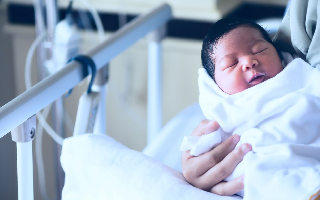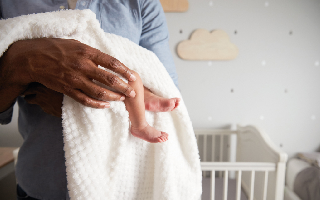
- No win. No fee.
- No hidden costs
- 100% risk-free, only pay if you win
- Home >
- Insights >
- Birth Injuries >
- Understanding the impact of Erb’s Palsy
About the Author
Alan Mendham
Medical Negligence Solicitor and Partner - LLB (Hons) University of East London
Read more about Alan »When you consider just how much we rely on our arms on a daily basis, whether it is typing at a computer, lifting shopping bags or simply picking up the phone, it can be daunting to consider how much a burden it would be to have this movement limited or removed altogether.
For those affected by Erb’s Palsy, this is a reality they may be faced with from the moment they are born. The impact of this condition on shoulder and arm mobility can drastically alter their lifestyle as they grow up, place additional pressure on parents to accommodate their needs, and result in them missing out on major childhood milestones.
Below we will explore what Erb’s Palsy is and how it is caused, the consequences this condition can have on a child’s development, and how you can make an Erb’s Palsy claim if this injury was a result of an act of negligence.
Understanding the impact of Erb’s Palsy
What is Erb’s Palsy?
Erb’s Palsy is a form of obstetric brachial plexus disorder, caused by damage to the nerves of the shoulder during birth. It is estimated that between one and two babies out of every 1,000 will be born with Erb’s Palsy.
There are five primary nerves that supply movement and feeling to an arm. During a difficult birth, it is possible for one or more of these to be stretched or, in the worst-case scenarios, torn during birth, which then affects the growth and mobility of the affected arm following birth.
For some, the damage will be minor, and will completely heal either on its own or with some physiotherapy work. For others, the damage can be so severe that they are left with a life-long disability, limiting the function of their arm and compromising their daily lives.
The extent of the damage done to these nerves will be dependent on the amount of force placed on the baby’s shoulder during birth and how long the stretching lasts. If the stretching is minimal and brief, the baby could only suffer neuropraxia, a mild form of nerve injury where the nerves do not tear, meaning they are likely to heal over time.
However, if the pressure on the shoulder is more severe for a longer period of time, it could cause the nerves to tear and rupture. Depending on the severity, this can significantly limit the movement of the baby’s arm for the rest of their life, as well as impact its potential to grow.
What is the difference between Erb’s Palsy and Klumpke’s Palsy?
Both Erb’s Palsy and Klumpke’s Palsy are types of brachial plexus conditions that limit the function of parts of a person’s arm.
However, while Erb’s Palsy is caused by damage to the upper brachial plexus nerves, Klumpke’s Palsy is the result of damage to the lower nerves. This means that it can cause limited mobility or paralysis in a person’s fingers, hands and forearms, while Erb’s Palsy will affect the upper part of the arm primarily.
Depending on the severity of the nerve damage, both can have long-term consequences on the affected person.
What causes Erb’s Palsy?
The overwhelming cause of Erb’s Palsy is a difficult or rushed birth. If a midwife or obstetrician has concerns about how quickly a birth needs to occur, for instance, if there is evidence the baby is suffering from oxygen deprivation, there is greater pressure on all involved.
This can lead to a birth injury called shoulder dystocia. This is where one or both of the baby’s shoulders become stuck, typically against the mother’s hard pelvic bone. When the midwife or obstetrician is trying to deliver the baby quickly, pulling a baby in this situation against the resistance of the pelvic bone can strain and tear the brachial plexus.
There are a number of accepted manoeuvres and actions that healthcare providers are trained to employ in these situations in order to help free the baby’s shoulder from this predicament. However, if they are applied too late, incorrectly or are ignored altogether, it can cause serious damage to the baby’s shoulder, which can then lead to them suffering Erb’s Palsy.
Another potential cause of Erb’s Palsy is excessive pressure being placed on the baby’s raised arms during a breech delivery (i.e. feet-first). Again, midwives or obstetricians in these scenarios are expected to take care of manoeuvring both mother and child to best relieve the pressure on the baby’s shoulder.
While Erb’s Palsy can occur during any birth, there are a number of factors that increase the risk of this possibility:
- The infant being untypically large or having a high birth weight
- The mother’s pelvis being abnormal or overly small
- Maternal diabetes
- Excessive maternal weight gain prior to the birth
- Use of birth assisted tools, such as forceps or ventouse
- The second stage of labour lasting over an hour
- If the mother has given birth to another child that suffered shoulder dystocia
It is therefore crucial that healthcare professionals accurately screen mothers prior to delivery and complete an accurate medical history, which is then noted by the midwives and obstetricians responsible for managing the birth. This ensures that, where necessary, a Caesarean section can be arranged to prevent this birth injury from occurring.
How can the negligence of a healthcare provider lead to Erb’s Palsy?
As alluded to above, there are a number of manoeuvres and actions that a healthcare provider can take when it becomes apparent that a baby has become stuck during birth and they need to limit the potential damage to their shoulder:
- The McRoberts Manoeuvre, where the thighs of the mother are pushed outward and towards their chest in order to widen the pelvis
- The Gaskin Manoeuvre, where the mother positions herself on all fours with an arched back, again to help widen the pelvis
- Suprapubic pressure, where an attendant will try to manually dislodge the baby’s shoulder from the mother’s pelvis, either by pressing down on their lower abdomen or by placing their hand above the pubic bone and pushing the shoulder one side or the other
- An episiotomy, where an incision is made to enlarge the vaginal opening to ease the birth
Sometimes, even if these actions are applied, damage to the shoulder simply cannot be avoided. However, if the healthcare professional in question fails to apply these at a reasonable time, or they are conducted incorrectly, any injury suffered by the baby could be seen as a result of negligence, and the person affected could be entitled to compensation.
How can Erb’s Palsy impact on someone’s life?
The extent of the injury with Erb’s Palsy is very wide, and each situation is unique. Some will have a transient weakness of the arm, elbow or shoulder, which may heal on its own over time or through physiotherapy.
Others might endure restricted growth and some loss of function. Unfortunately, those at the furthest end of the spectrum could be completely unable to use their arm or hand, which carries significant lifelong implications.
It also depends on which arm is damaged in relation to the individual’s preferred hand – something that is decided at birth. If their dominant hand is the one affected by Erb’s Palsy, the impact on their life can be even more substantial, as they have to learn to function with their weaker hand.
First, there is the cost of ongoing physiotherapy to consider, in order to manage the movement of the person’s joints and best look after the health of the affected arm. There might also be the possibility of surgery to attempt to repair the damaged joints.
This is heightened by any expenses that are required to modify the baby’s accommodation or surroundings to minimise the impact of their disability and improve their quality of life, such as voice-activated technologies and other specialist equipment.
If their condition will remain across their life, these adaptations and equipment needs will only grow in order to help them live as independent a life as possible. Think of everything that you do on a daily basis that requires two hands:
- Opening tins and packages
- Driving a car
- Lifting heavy objects
- Bathing and dressing
Consequently, this also places a burden on the affected individual’s loved ones, who will likely need to assist their child with these tasks. This may impact their ability to earn money as they are required to look after their child, as well as their overall quality of life. Alternatively, there would be the cost of hiring carers to take care of their children while they are at work.
Finally, while we cannot ignore the physical impact that Erb’s Palsy can have on an individual, it also can cause the affected individual a lot of emotional trauma as well. The need for additional assistance at school or abnormal growth of their arm could alienate them from their peers, as well as restrict their independence.
Plus, they will likely miss out on a number of pivotal childhood events and pastimes that many of us take for granted, such as riding a bicycle, swimming or playing sports and other outdoor games. While schools should make every effort to be inclusive of those with Erb’s Palsy, the experience can be an emotional and psychological struggle for those affected.
Making a claim for Erb’s Palsy
For this reason, it is important that, if your or a loved one’s child is diagnosed with Erb’s Palsy as a result of the negligence of their healthcare providers, you receive the answers, compensation and justice you deserve.
At Gadsby Wicks, we go to every effort to understand the circumstances behind your Erb’s Palsy claim, investigate the available evidence and, if we believe your treatment was negligible, guide you towards a successful outcome.
As part of this, we will take detailed witness statements from you and assess the relevant medical records. We will also take expert advice from independent Obstetricians, Midwives, Paediatricians and other healthcare providers to determine if the Erb’s Palsy could have been prevented through better medical care.
If you would like to make a claim, or would like to learn more about our focused, comprehensive approach to medical negligence, please get in touch with our team today.
Disclaimer
All content contained within this article is meant for general information only – this should not be treated as a substitute for medical advice from your doctor or another healthcare provider. If you require legal advice specific to your situation, please contact our team directly.
Gadsby Wicks is not liable for any diagnosis made from the content of this article, nor does it endorse any service or external site linked to within the article.
Always consult your GP if you are concerned about your health and wellbeing, or speak to us if you require legal advice.





 Back to top
Back to top

